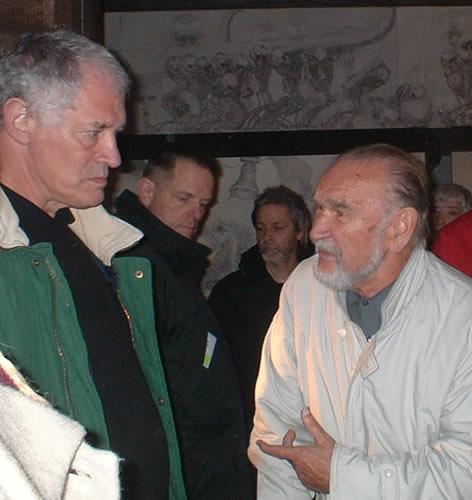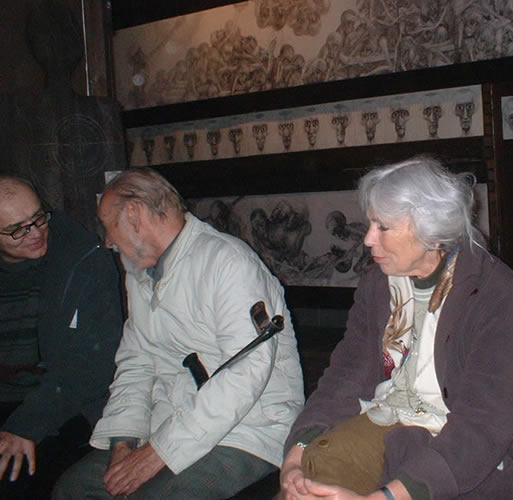On our first way to the double concentration camp of AUschwitz-BirkenAU
we passed a sign:
"Harmeze" .
"What is this!" I asked Yanina, as if haunted by something.
She said: "It's just the name of a village, I think."
But the letters H A R
M had already imprinted themselves in my mind and soul.
In English these four letters mean "damage or injury",
In German they imply even more pain:
"Harm" means "deep sorrow".
Then, one evening, the group was brought to Harmeze.
We were to see Marian Kolodzieja's Labyrinth.
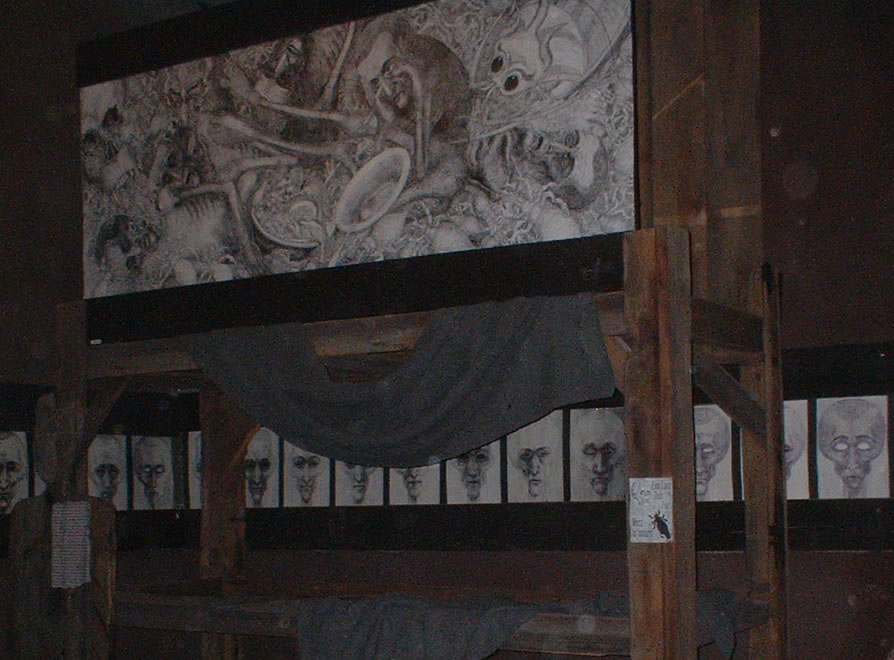
And - a wondrous coincidence - Marian and his wife and companion
Halima were there too.
Later I learnt, that they lived in Gdansk-Danzig, 7 train-hours
away .
We had about two hours and I was so taken by the experience,
that I suddenly knew, where I wanted to spend the two days after
the retreat,
which I had wisely scheduled beforehand, guessing
that I would need to take the time "to wait for my soul to
come after me."
I boldly asked, if I could spend these two days in the monastery,
next to Marian's paintings.
Later - on our twosome visit of the labyrinth - Pater Stanislaw
quoted someone who said:
"This is the real Auschwitz".
We both agreed on it.
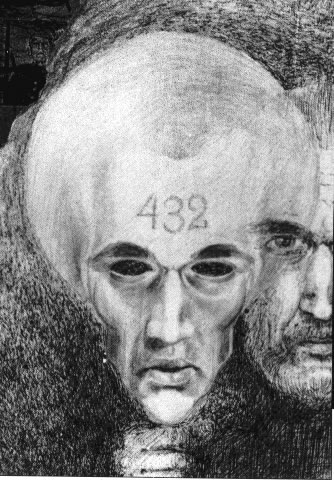
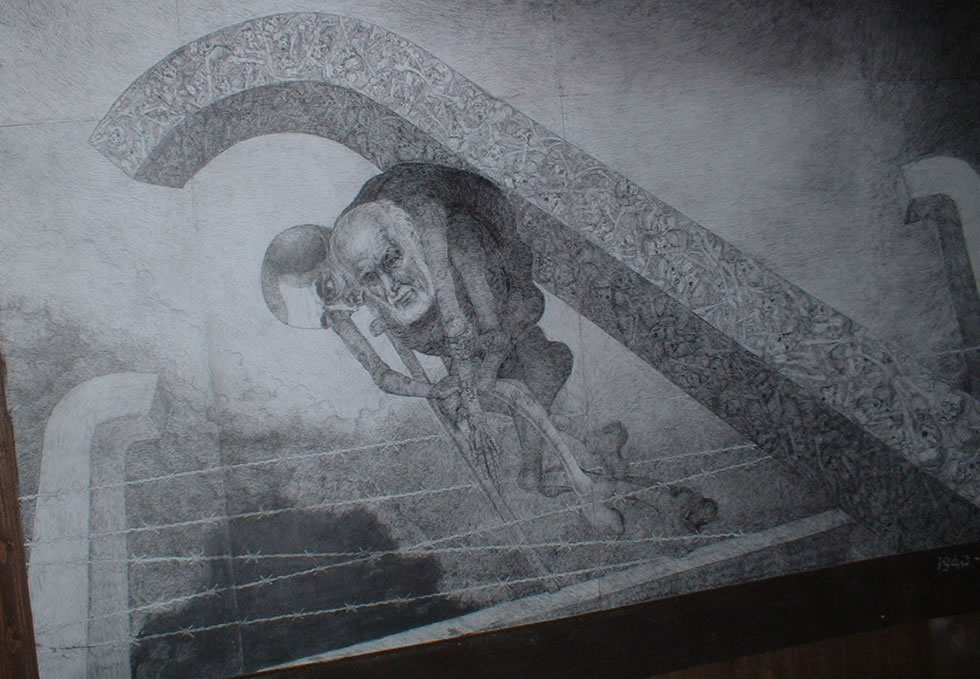 This theme - the barbed wire fence and the cross represented by
the fence poles - recurs in the paintings,
This theme - the barbed wire fence and the cross represented by
the fence poles - recurs in the paintings,
and so does the theme of the old Marian, the survivor, carrying
the young Marian, the prisoner and slave, on his shoulders under
the cross
Or the young Marian leading the hand of the old Marian in painting
his memories.
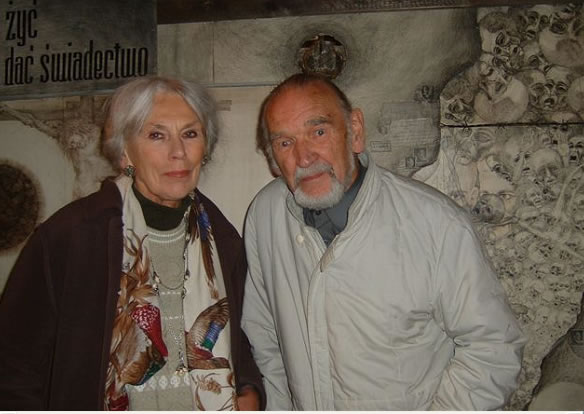
Marian and his beautiful wife Halima
The Poles among us like Andrzey (left
photo) and Pawel (right photo)-
and those Israelis among us who spoke Polish like Yanina -
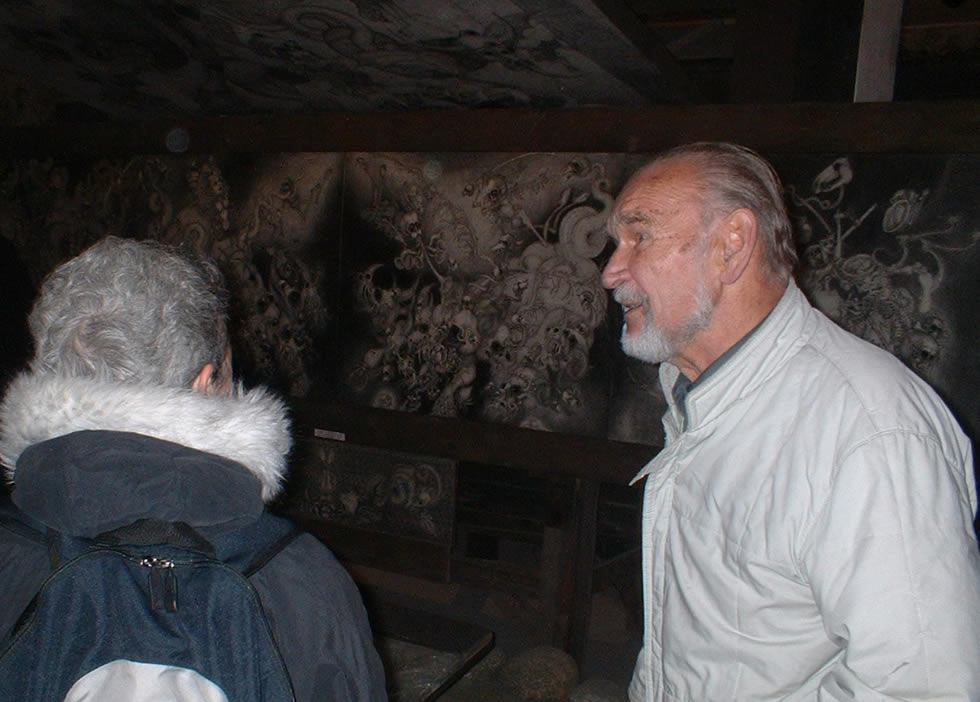
had the chance to listen to Marian's comments and stories directly.
One story was translated to me:
"Marian Kolodzieja" isn't the name he was born with.
It so happened that a perpetrator wanted to use his skill for drawing
something,
maybe a birthday blessing or a love-letter (could they love???)
The extra soup he got for this work he shared with another prisoner.
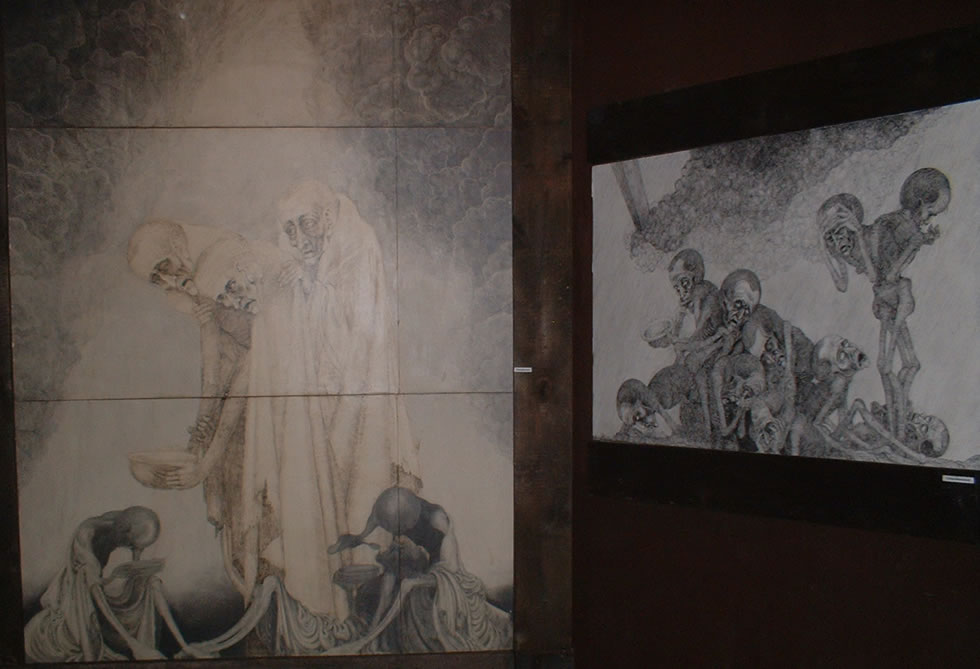
Later, when he was in the death cell awaiting his execution,
that prisoner happened to be responsible for "the archive".
He managed to push the document of the soup-sharer's death-sentence
always underneath the pile
until one day he succeeded in replacing it with the "Identity
Card" of a Number already executed.
"It means that I actually don't exist
anymore.
I adopted the name of that murdered man: Kolodzieja (pronounced
Kowodzieja)."
What I now - in sculpting this story - don't understand, is,
if the Nr. 432 - imprinted on so many figures in Marian's painting
- is the original or the adopted number?
But does it matter?
Then, on my last night,
for two hours alone in Marian's "Labyrinth" with Pater
Staniswav Stoi,
we pondered over an idyllic scene, placed above one of Marian's
gruesome paintings.
The idyll showed Marian, the prisoner,
mowing grass with a skythe
and digging a pond.
"It's German propaganda",
said the priest, with anger, grief and disgust.
And though he came to live in the monastery only a month earlier,
he knew:
"There were small natural ponds dispersed
around here in Harmeze.
The villagers of Harmeze were expelled and a subcamp of Auschwitz
was erected
The first prisoners like Marian were brought to Harmeze to dig out
fish-ponds."
Whenever the priest mentioned Harmeze, it sounded like the Hebrew
Khaermêsh.
I shuddered.
Khaermêsh means "skythe",
in German "Sense".
And the connotation was the "Sensenmann", the man with
the skythe,
the personalization of DEATH in the old legends.
Harmeze - harm and Harm and DEATH...

"But who would do the fishing here and who would eat the fish,
definitely not the prisoners."
"That's the whole point: there was no real interest in the
prisoners' work-force.
There was no need for most of the things, the slaves were forced
to produce.
It was just for the sake of torture.
If they had been interested in getting any real work done effectively,
they would have given the slaves water, food and sleep."
I couldn't help remembering a famous Guru in India,
who demanded from his followers (some 20 years ago),
to shovel a huge hill from one side to the other...
I had never thought of this possibility.
After all there is "Schindler's List", for instance, which
proves,
that people could be saved, if work vital for the German Reich could
be done by them.
But Marian's mowing with a skythe and digging fish ponds proved
the priest's point.
And this aspect of torture made it all the more vivid to me,
that the "Endloesung",
the ideological concept
of extermination,
was not the main thing.
If yes, gassing all newcomers immediately would have been the only
efficient way to Accomplish it.
There was room for 2000 people, a whole train, in one gas-chamber.
True, the burning of the corpses was more cumbersome
and to Accomplish it, some slaves needed to be kept alive for the
Sonderkommando.
And some others for exploiting all the belongings of the murdered,
including their hair and gold teeth etc
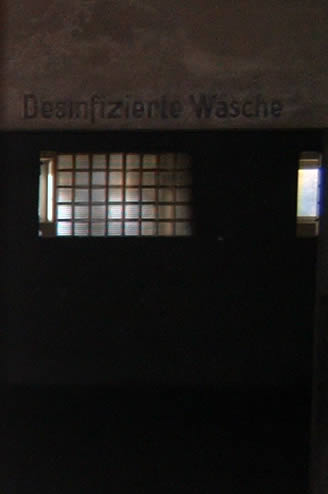 |
"Desinfected
Laundry" and Protheses of the Handicapped
were only two of orderly piled up utensils of the murdered.
Most of this colossal amount of plunder
- like the hair of the women and these protheses
probably never found consumers, even in a time of war...
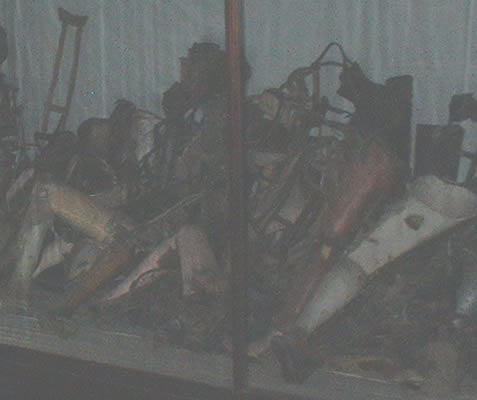
|
They could have gassed the people in their clothes and with their
hair intact.
No economic interest demanded to strip them naked and shear them
like sheep.
There again was only one interest:
the kick of humilating and torturing living co-humans.
The kick was desired as compensation for the rich skala of feelings,
which are LIFE
and which had been first ignored and denied like in ordinary people,
and if a rest was left, then this rest was systematically erased,
blotted out.
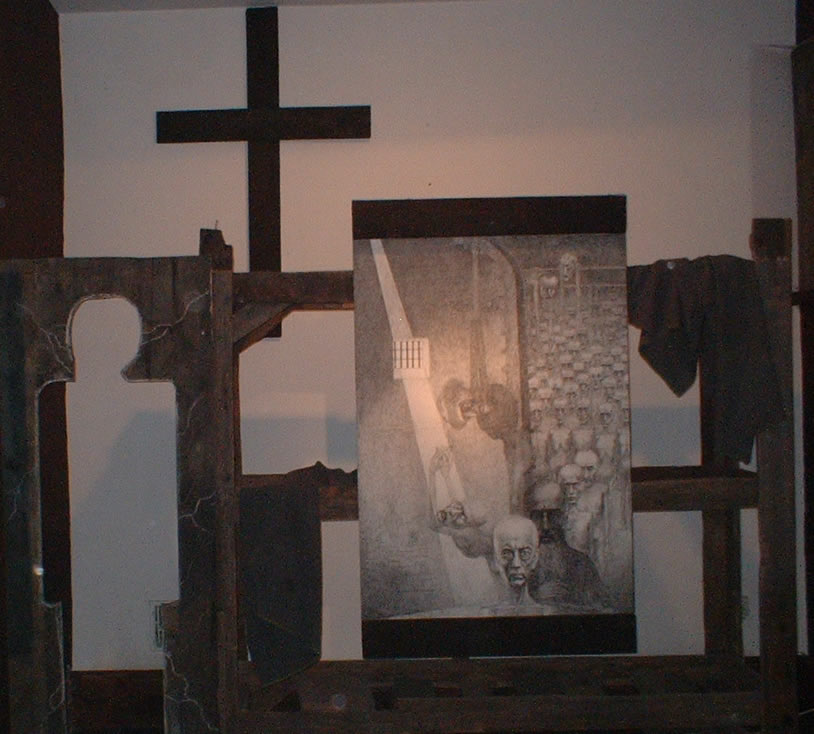
"What do these holes in human shape mean?"
I wondered with the priest.
"Probably, the nothingness of those numbers,
like the negatives of clay sculptures."

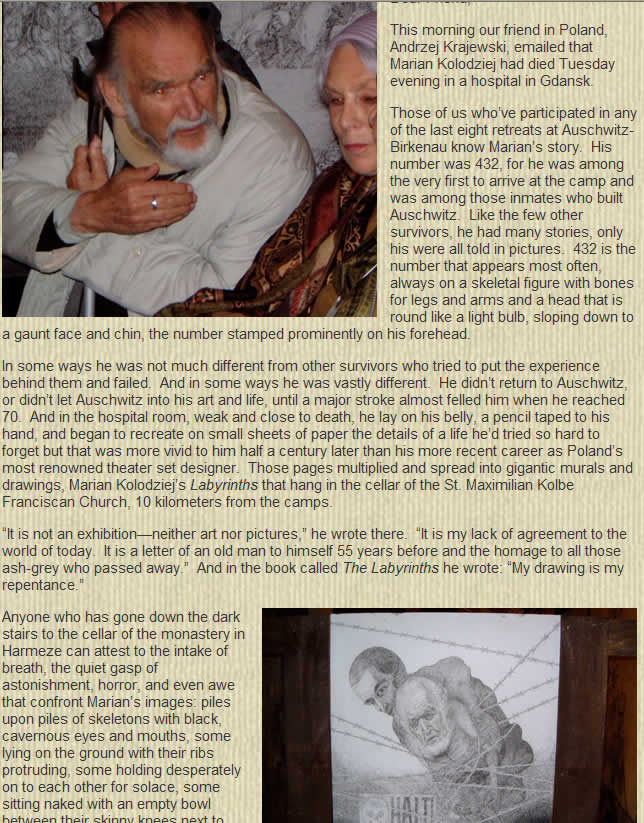


 This theme - the barbed wire fence and the cross represented by
the fence poles - recurs in the paintings,
This theme - the barbed wire fence and the cross represented by
the fence poles - recurs in the paintings, 
